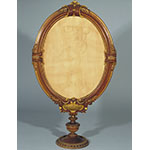The oval frame with feet and gilt friezes contains a copy of the original drawing made by Vincenzo Viviani and by Galileo's son, Vincenzo. It reproduces the apparatus illustrated by Galileo in his letter of June 1637 to Laurens Reael, in which he explained his method of determining the longitude based on the observation of the periods of Jupiter's moons. This solution required a very precise time-keeping system. To this end, Galileo proposed a clock (inv. 2085) of his invention that made use of the isochronism of pendulums of equal length, a principle discovered by Galileo himself. A report by Vincenzo Viviani tells of that discovery and of Vincenzo Galilei's role in it. The discovery of the application of the pendulum to the clock was claimed in 1658 by Christiaan Huygens, whose assertions were vigorously challenged by Viviani.









